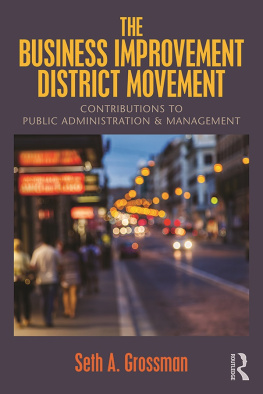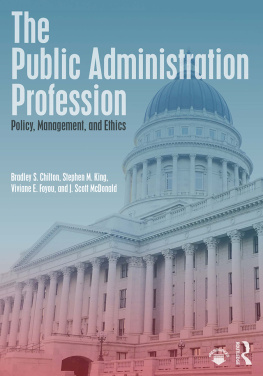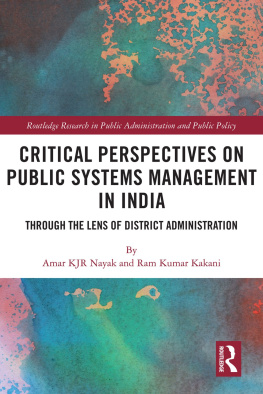The Business Improvement District Movement
This comprehensive book covers the theory and practice of business improvement districts (BIDs)partnerships between local communities and governments established to revitalize neighborhoods and catalyze economic development in a region. In this book, author Seth A. Grossman demonstrates the ways in which BIDs work, pull stakeholders together, and acquire funds to manage the difficult process of community revitalization especially in urbanized, threatened town centers. BIDs also blur traditional lines between public and private organizations, and their governance raises critical new questions about democratic representa-tion, accountability, transparency, and responsiveness.
As this book illustrates, BID managers act as public entrepreneurs, and management in the public realm requires community development skills (community planning, organization, and leadership) and economic expertise (jobs, business development, housing, and public infrastructure). Through an in-depth examination of BIDs and their managers we begin to see that the future of public administration might no longer be contained behind the walls of formal government, with an increas-ing number of public administrators defining and creating public solutions to real life commercial problems. This book is essential reading for all practicing urban and regional administrators and government officials, as well as students studying public administration, public management, and urban and regional politics.
Seth A. Grossman is Executive Director of the Ironbound Business Improvement District in Newark, New Jersey and President of Cooperative Professional Services, a consultancy that provides research, planning, and management services to Business Improvement Districts. He designed and directs the Rutgers University National Center of Public Performance Online BID Management certification program as well as the Business Improvement District Program for the State of New Jersey.
THE BUSINESS IMPROVEMENT DISTRICT MOVEMENT
Contributions to Public Administration and Management
Seth A. Grossman
First published 2016
by Routledge
711 Third Avenue, New York, NY 10017
and by Routledge
2 Park Square, Milton Park, Abingdon, Oxon OX14 4RN
Routledge is an imprint of the Taylor & Francis Group, an informa business
2016 Taylor & Francis
The right of Seth A. Grossman to be identified as author of this work has been asserted by him in accordance with sections 77 and 78 of the Copyright, Designs and Patents Act 1988.
All rights reserved. No part of this book may be reprinted or reproduced or utilised in any form or by any electronic, mechanical, or other means, now known or hereafter invented, including photocopying and recording, or in any information storage or retrieval system, without permission in writing from the publishers.
Trademark notice: Product or corporate names may be trademarks or registered trademarks, and are used only for identification and explanation without intent to infringe.
Library of Congress Cataloging in Publication Data
Names: Grossman, Seth A., author.
Title: The business improvement district movement : contributions to public administration and management / by Seth A. Grossman.
Description: New York : Routledge, 2016. | Includes bibliographical references and index.
Identifiers: LCCN 2015046616| ISBN 9781498747721 (cloth : alk. paper) | ISBN 9781138668898 (pbk. : alk. paper) | ISBN 9781315619040 (ebook)
Subjects: LCSH: Community development, Urban. | Enterprise zones. | Local government. | Public-private sector cooperation.
Classification: LCC HN49.C6 G76 2016 | DDC 307.1/4068dc23
LC record available at http://lccn.loc.gov/2015046616
ISBN: 978-1-498-74772-1 (hbk)
ISBN: 978-1-138-66889-8 (pbk)
ISBN: 978-1-315-61904-0 (ebk)
I thank Rutgers, the State University of New Jersey and The School of Public Affairs & Administration, the numerous BID managers throughout the United States, Australia, Europe, and Canada (and the world) for their support and participation in conducting necessary research. Special thanks to Marc Holzer, the City of Newark (NJ), the Ironbound Business Improvement District (Newark, NJ), the Bergen-Lyons-Clinton Partnership (BID-Newark, NJ), and the Mount Prospect Partnership (BID-Newark, NJ). Special gratitude to: Lawrence Houston, Jr., Gktug Morl, Lorlene Hoyt, Jack W. Meek and Ulf Zimmerman, David Feehan and Marvin Feit, Jerry Mitchell, Morton E. and Sarah N. Grossman, Downtown New Jersey, Inc., the New Jersey Managed Districts Association, the International Downtown Association, International Cities, Town Centres and Communities Society, the Association of Town Center Management, and the American Society for Public Administration.

Seth A. Grossman (Ph.D., Public Administration, Rutgers University-Newark, NJ) is the Executive Director of the Ironbound Business Improvement District (IBID) in Newark, NJ (United States), and President of Cooperative Professional Services, a consultancy that provides research, planning, and management services to BIDs. He was a senior planner with the City of Trenton, NJ (United States), and was designer and administrator of the Business Improvement District Program for the State of New Jersey (United States). He is co-founder and Past President of the New Jersey Managed Districts Association (NJMDA), an advocacy organization dedicated to the profession of business district management. He designed and directs the Rutgers University-Newark, NJ, National Center of Public Performances Institute of Business District Management and the online Business Improvement District Executive Management Certification Program. His research is on partnership governance, BIDs, publicprivate partnerships, entrepreneurship, and the rise of special districts.
Business Improvement Districts (BIDs) are units of sub-government based on special assessment forms of public financing that create a formal publicprivate partnership and a local self-help mechanism to address revitalization and redevelopment needs of a designated business area. Unlike state or county governments, it is difficult to determine the exact number of BIDs because they are established locally with little reporting requirements to state government and they are continually being created. Yet, it is clear BIDs are a dynamic growth field in government. This book examines how BIDs create synergy and a synthesis of traditional public and private capability to unfold a hybrid new capability that borrows from each sector. We cannot ignore that this synthesis is compelling for some and a concern for others, and grappling with its exact governmental nature is ongoing. There is a general consensus that BIDs work and pull stakeholders together, and acquire needed funds and manage the difficult process of community revitalization, especially in urbanized and viable but threatened town centers. Performance data, however, is not succinct, as a thorough public, private, and customer evaluation method has not been developed or vetted. The chapters in this book go beyond descriptions of the promise of BIDs and keenly address the issue of the performance of BIDs, and how it might be applied to these unique organizations. Lloyd and Peel (2008) speak about a need for a more sensitive performance tool that addresses the multidimensional publicprivate processes that BIDs represent.











